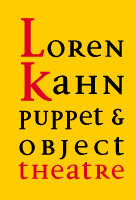 |

 |
 
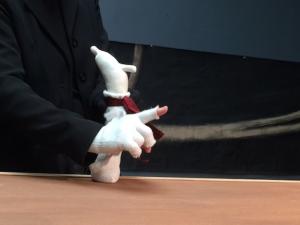
|

|
Schpountz and the Others
Schpountz and the Others
A show for 4th and 5th grades. Performances funded by the County of Bernalillo and UETF of the City of Albuquerque.
The following is partial text of a booklet given to teachers, as a pedagogical tool to use after the show:
The play, Schpountz and the Others, was conceived like
a riddle, without language, and is about differences and feelings.
Can we identify the feelings of others? Do we have the same feelings for the same reasons? The show plays on the fine line between sympathy, empathy and compassion.
First scene: No Way?!
Schpountz, who likes everything in order, informs us that he is subject to vertigo, a difficult situation when you live on an elevated surface, and he doesn’t like it when a bird takes the liberty of losing a feather above his territory. When he finally gives his attention to the audience, the fact that they don’t have schpountzes on their heads, gives him irrepressible giggles, which oblige him to leave the stage.
Second scene: Choosing
After a storm litters the ground with branches, Schpountz has to clean up. But one branch then another and another attract his attention. Which one to keep: the utilitarian, the funny one, the dreamy one or THE powerful one? Left with nothing, Schpountz leaves the stage in despair.
Third scene: Unfair
Et voilà! It never fails! Schpountz has a stain on his silk scarf and it makes him feel sorry, but also brings him to rage against the world: why me, always the same, unjust, unfair, and yesterday and before yesterday… and so on. Filled with the outrageous feeling of injustice, anger drives Schpountz from the stage.
Fourth scene: Boredom
Schpountz does not know what to do with himself. Can imagination be fertilized by boredom and even make us sick? The emergency of a sick stomach pushes Schpountz to leave as quickly as possible.
Fifth scene: Poor Me
Schpountz gets a splinter and goes from joy to pain,
from courage to self-pity. Cuddling his damaged foot, Schpountz departs to recover.
Sixth Scene: Tomorrow
We feel it for a long time, sure about our decision, but at the last minute tomorrow looks to be a better possibility to try again. Schpountz promises himself that tomorrow he will have the courage to face his fear, yes tomorrow.
Seventh scene: Help
Offered the possibility to express himself with a blackboard, Schpountz, after hesitation and consideration, writes “help” on the slate, then disappears: end of the show, beginning of the discussion.
Each scene is punctuated by a gong, symbol of time passing.
Function of the show: to encourage thinking!
Little list of discussion subjects:
- Who are the Others?
- What could we do for Schpountz?
- Guess titles for the scenes
- Can we, as spectators, increase and tame our sensitivity with the tool of art?
- Is there a difference between feelings induced by fiction or by “reality?”
- Besides “like or don’t like,” other verbs to name an emotion or a feeling?
- Are words a help to enlarge our spectrum of nuances of feelings and emotions?
Attempt of
clarification between
sympathy and empathy:
sympathy ;| noun (pl. sympathies)
1 feelings of pity and sorrow for someone else's misfortune: they had great sympathy for the flood victims.
• (one's sympathies) the formal expression of pity or sorrow for someone else's misfortune; condolences: all Tony's friends joined in sending their sympathies to his widow Jean.
2 understanding between people; common feeling: the special sympathy between the two boys was obvious to all.
• (sympathies) support in the form of shared feelings or opinions: his sympathies lay with his constituents.
• agreement with or approval of an opinion or aim; a favorable attitude: I have some sympathy for this view.
• (in sympathy) relating harmoniously to something else; in keeping: repairs had to be in sympathy with the original structure.
• the state or fact of responding in a way similar or corresponding to an action elsewhere: the magnetic field oscillates in sympathy.
ORIGIN late 16th cent. ( sense 2): via Latin from Greek sumpatheia, from sumpathēs, from sun- ‘with’ + pathos ‘feeling.’
empathy | noun
the ability to understand and therefore sharing the feelings of another without feeling them ourselves. Empathy: in side + pathos
In a way, the difference between sympathy and empathy is the difference between feeling with and understanding inside.
We note the same kind of differentiation or nuance between emotions (impulses, movement) and feelings (states).
We can feel both separately or at the same time.
And what about double feelings like:
Schadenfreude, n.
pleasure felt at someone else's misfortune.
[1890–95; < German, Schaden harm + Freude joy]
Random House Kernerman Webster's College Dictionary, © 2010
|
|
 |
 
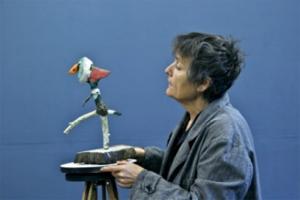
|

|
To Feel is in Question
A show/lecture for adults.
To watch, to feel, to figure out, to decipher, to understand, to situate ourselves, are among many actions we make as spectators.
Nevertheless, we commonly associate spectator with passivity. Why?
Our societies celebrate artists, “emitters,” and discount spectators, “receivers,” creating a hierarchy, which I, Isabelle, would like to put in question.
|
|
 |
|

|
|
 |
 
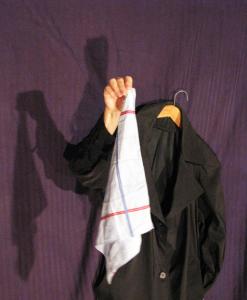
|


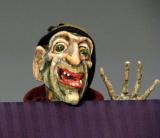


|
Insomnia
Take a dark and stormy night. Add a teaspoon of bad conscience, an ounce of guilt, a pinch of regret, a dollop of confused thoughts, sprinkle with hope (don’t forget a cup and a half of humor), then shake well: welcome to the realm of Insomnia.
Isabelle Kessler, Loren Kahn and Alex Knight present a new production for adults. Music, movement, language, theatre, puppets and objects explore the thoughts and struggles which surface during a sleepless night, when we finally have time to think!
Running time: approximately 35 minutes, followed by a 10-15 minute discussion session.
Gaspard Le Dem is the composer of the music for Insomnia" 
|
|
 |
 
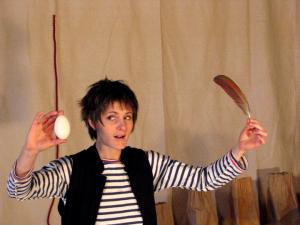
|


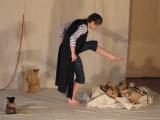


|
String
A Dance & Object Show for young children
Key, the character, is waiting, her back to the audience playing cat’s cradle. Opening herself to the stage, she discovers the red winding rope, symbol of life to be tamed. Following the rope, Key finds the large bundle and unpacks seven brown paper bags. Each bag holds another emotion, the seventh, the bag of dreams and future, will be opened ... tomorrow.
The set is a metaphor for a blank page: a natural canvas back drop (6’x 9’); a slightly bigger canvas on the floor; upon it a brilliant red rope leading to a huge canvas bundle.
String is a show where Marie Margaret Moore, actress and dancer, and Isabelle Kessler, director and writer, have woven three expressions: dance, theatre and object theatre. Their goal is for children to explore the emotions and power of imagination. To reach this goal they decided to take the path of simplicity: very few objects, a very simple setting, no music tracks, no lights effects, just a human being curious about her feelings, from fear to joy.
A review in Seattle's Child" of a performance of "String" at the Frye Museum of Art, Seattle, Washington State
|
|
 |
 

|


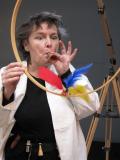


|
Isabelle Kessler performs It's Time
|
It's Time
A character, dressed all in gray, arrives in her workshop. In this quiet gray nest, color is born, feather by feather. A yellow feather: the sunrise? A blue feather: storm of blue sky? Story fragments create a bird, then an egg -- what color will it be? Simplicity and tranquility are explored in this performance, which was created for the age when each moment is a discovery and magic is in the emotions.
It's Time is a new object theatre production for the very young performed by Isabelle Kessler. It is the American cousin of Qui dit gris, a French show created by Therese Angebault and Isabelle Kessler.
Audience maximum: 30 children (ages 1-3 or 3-5) plus any comfortable number of adults. Running time: approx. 30 minutes
See a video of Its Time on Vimeo!
|
|
 |
 
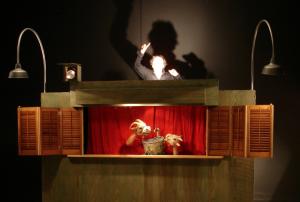
|


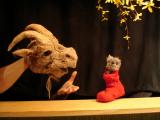


|
Billy Goat Ballad
Cornebique, a billy goat and big fan of the blues, hits the road, to forget an unrequited love. He finds himself, unexpectedly, in charge of a tiny dormouse, an animal of which he has never heard! Flesh, Weasel, special agent, is on their trail. He means to capture this last remaining male dormouse and reunite him with the sole remaining female, in order to create the world’s biggest corporate food supply for ... weasels.
Adapted from La Ballade de Cornebique by French author Jean Claude Mourlevat.
The set is constructed of a big box, 7 feet long, 6 feet high, and 4 feet deep. A wide window has shutters which magically open and close on universes as different as a sweetheart rendezvous, a desert and a labyrinthian palace.
Billy Goat Ballad is intended for families and elementary school-age audiences. Audience maximum: 100. Running time: 65 minutes.
|
|
 |
 
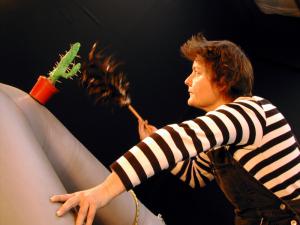
|


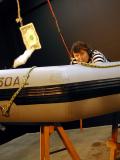


|
What a Choice!
A one-woman object theatre performance for adults. Bernadette Barbotine is in an inflatable life boat atop saw horses. Her lighthouse is a glass of water -- half full or half empty? Is it better to belong to the idiotic optimists or to the boring pessimists? What a choice!
Audience maximum: 200. Darkness required. 70-minute performance.
We are pleased to let you know that we have a 9 minute (edited) video of this piece online! Click the right bottom thumbnail above, or click the link below to download.
You may also request a longer (22 minute) DVD of this video! Please contact us by emailing us at info@lorenkahnpuppet.com.
Click to download video of What a Choice (114MB)
email us to request a DVD
|
|
|
 |
|
 |
